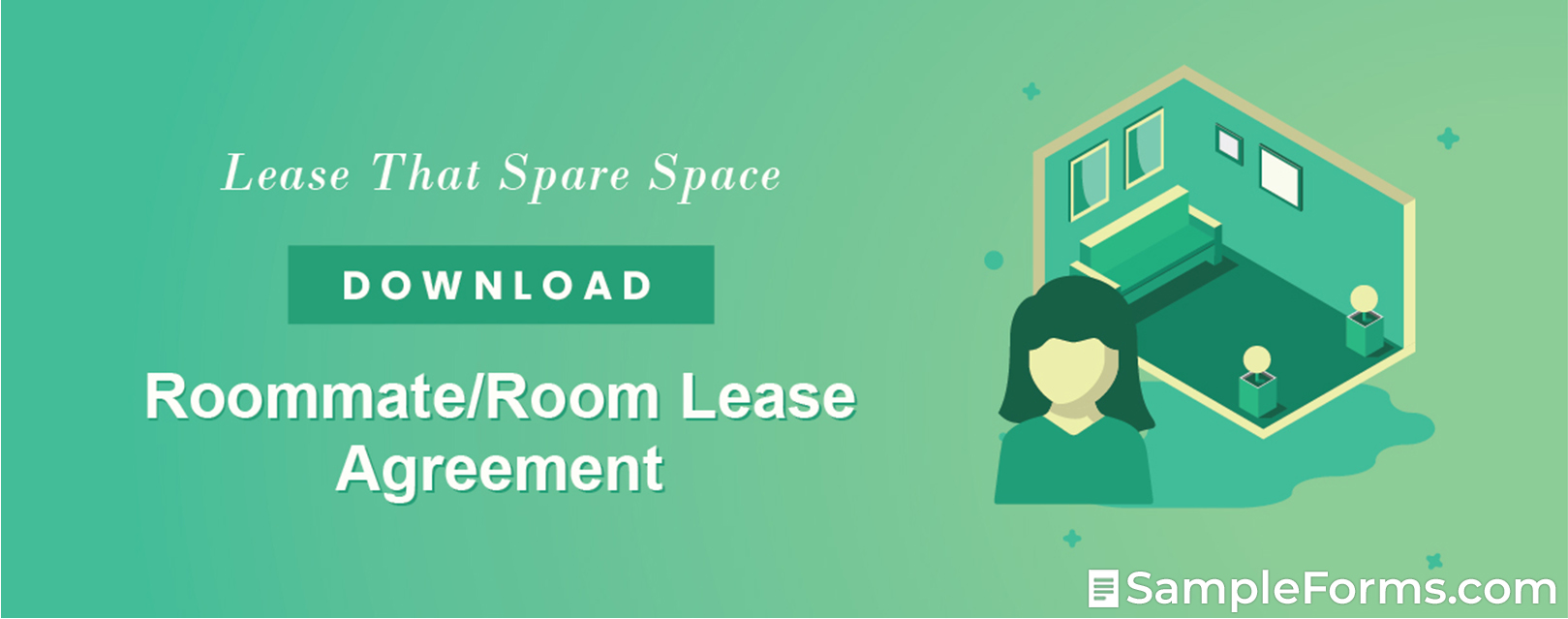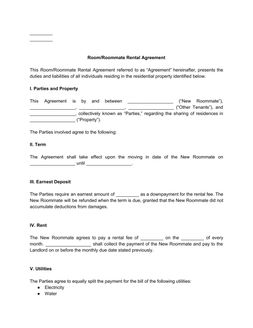- Eviction Notice Forms
- Power of Attorney Forms Forms
- Bill of Sale (Purchase Agreement) Forms
- Lease Agreement Forms
- Rental Application Forms
- Living Will Forms Forms
- Recommendation Letters Forms
- Resignation Letters Forms
- Release of Liability Agreement Forms
- Promissory Note Forms
- LLC Operating Agreement Forms
- Deed of Sale Forms
- Consent Form Forms
- Support Affidavit Forms
- Paternity Affidavit Forms
- Marital Affidavit Forms
- Financial Affidavit Forms
- Residential Affidavit Forms
- Affidavit of Identity Forms
- Affidavit of Title Forms
- Employment Affidavit Forms
- Affidavit of Loss Forms
- Gift Affidavit Forms
- Small Estate Affidavit Forms
- Service Affidavit Forms
- Heirship Affidavit Forms
- Survivorship Affidavit Forms
- Desistance Affidavit Forms
- Discrepancy Affidavit Forms
- Guardianship Affidavit Forms
- Undertaking Affidavit Forms
- General Affidavit Forms
- Affidavit of Death Forms
Roommate/Room Lease Agreement
Living with roommates is not always sunshine and rainbows. Sure, you have someone you can split the rent and utility bills with and someone who can help you with the chores. However, you can’t know in advance the months when they can’t afford to pay the rent, and you can’t tell whether they can help you with the chores or are the chores themselves. Hence, make sure that you and your roommates can sign a roommate/room rental agreement form to ensure a healthy roommate relationship and avoid future disputes. Read More
How Do You Create a Roommate/Room Rental Agreement Form?
To secure a healthy roommate relationship, roommates must cooperate and create a roommate/room rental agreement form to set things straight right from the outset. That said, be sure to take notes of the following guidelines below to create a comprehensive agreement form.
1. Determine the Parties Involved, the Property and the Term
Before presenting the duties and liabilities of each party, the names of the parties involved must be introduced first at the start of your agreement form. Next, indicate the details of the residential space or property you are sharing and include the duration of how long each of you will dwell in that specific space.
2. Outline Anything That Involves Financial Obligations
Earnest deposits, rental fees, and utility bill payments—these are often the financial obligations that roommates will have to deal with and split with. In your agreement form, write down all the details on how to settle payments, how to divide these obligations, and how to refund security or earnest deposits.
3. Establish House Rules and Policies
The lease you signed with your landlord might already cover house rules and policies, but it is good to consider creating your own set of rules among yourselves. When it comes to food, decide whether you will have a communal or individual setup. When it comes to pets, ensure that no one is allergic, and the landlord allows you to bring pets in the first place. When it comes to guests, set policies and arrangements for both short-term and long-term guests. And when it comes to maintaining the cleanliness of the space, set chore schedules to clean up common areas.
4. Include Policies on Privacy
Having a roommate is great because you have someone to share with not just financial obligations but as well as the companionship. However, each one of you will eventually need some downtime alone, whether you want to relax after a day’s work, a tiring school day, or a bad day in general. For that, make sure each of you will set this expectation in your very roommate/room rental agreement form to set each of your preferred time for complete privacy ad also consider your discussing each of your sleeping schedules.
5. Set Termination and Eviction Grounds
Your agreement form must specifically indicate the conditions on early termination and the grounds for eviction. In terms of early termination, cite each roommate’s right to move out of the property before the agreed and signed termination date and the conditions that allow it. In terms of eviction, reiterate what you have agreed with the landlord since the landlord reserves the right to evict anyone among you and your roommates.
Frequently Asked Questions
What are the common roommate problems you can prevent with a Roommate/Room Rental Agreement form?
As revealed by a Boise State University study, the common roommate problems include: partying, cleaning, sleeping schedules, stealing, borrowing, guest issues, bill disagreements, lack of respect and privacy, and not getting along. With a roommate/room rental agreement form, it enables you and your roommates to discuss and deal with the said common roommate problems before you start living together.
What is the main difference between a Residential Lease Agreement and a Roommate Agreement?
The main difference between a Residential Lease Agreement and a Roommate Agreement is based on which The parties involved are the main difference between these two agreements. The residential lease agreement consists of the landlord and the tenants, while a roommate agreement involves the tenants sharing a single living space.
Are Roommate Agreement forms legally binding?
There are some aspects of a Roommate Agreement that is legally binding such as the financial obligations, which include the duty to pay the rent and the utility bills. However, other components, such as your house rules and policies on household chores, guests, and so on, may not be legally enforceable.
Do you need to sign a Roommate Agreement form in front of a witness?
There is no need to sign a roommate agreement before a witness to make it valid. But if you consider signing in front of one, they can prove the legitimacy of the signatures in the agreement.
When will I need a Roommate Agreement form?
As soon as you share a lease with at one or more tenants, see to it that you will establish one right away to avoid experiencing going through the common roommate problems in the future.
With a roommate/room rental agreement set in place, you and your roommates should be fine as you start living together under the same roof. And the best part of it all is that you will avoid and prevent all the possible roommate issues and problems from happening down the road.

